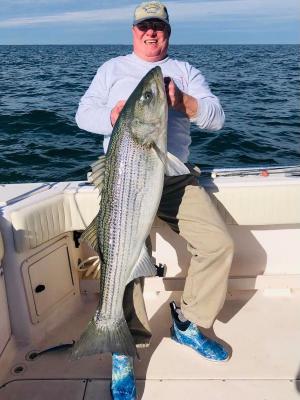As we begin 2022, there look to be a few changes in our fishing regulations. First, the good news. Summer flounder regulations may remain status quo. It seems the stock is stable, and according to the latest estimates from the Marine Recreational Fishing Program, we did not overfish our quota in the past few years.
The bad news is we may see a 28 percent decrease in the black sea bass quota. This is in spite of the fact that the spawning stock biomass is two-and-a-half times the recommended level for safe reproduction.
Why, you may ask, is the quota being reduced on black sea bass when the stock is so high? Well, it’s because, according to the bean (fish) counters at the National Marine Fisheries Service, we recreational fishermen overfished our quota several years ago. How, you may ask, did they figure this out? They took the new figures from the Marine Recreational Information Program, and went back and applied the new figures to the old numbers from the old MRIP and found out, lo and behold, those sneaky rec fishermen overfished black sea bass and we just found out.
Just to add to the confusion, NMFS has increased the amount of black sea bass and summer flounder the recreational fishermen can take while decreasing the amount the commercial fishermen can harvest. The difference is not earth-shattering, but it is a complete change in direction and something that should have been done many years ago.
When quotas were first established, commercial fishermen were awarded 60 percent of the summer flounder and recreational fishermen got 40 percent. There were a few of us on the recreational side who complained, but to no avail. Nothing had changed until this year, and even now the change is slight. Slight though it may be, the change could be just enough to keep us at status quo for 2022 when it comes to summer flounder.
There are no regulations on the books for 2022 as of yet. All of the states will have to come up with regulations to fit the NMFS guidelines sometime before May 15, when the black sea bass season opens in Delaware and Maryland. One option may be a 14-inch minimum size and an open season from May 15 to Sept. 21. I expect Delaware to hold a hearing to discuss any options we have on black sea bass regulations.
Fishing report
Wow! The year really did go out with a bang. The big news was rockfish from Cape May to Ocean City. That’s right, for the first time since Superstorm Sandy in 2012, the coastal stock of striped bass has moved down the Atlantic Coast past Delaware and Maryland. And what a stock it is. Every fish caught was either in the 28- to 35-inch slot or well above the 35-inch maximum.
According to all the reports I read, the two most effective lures were Mann’s Stretch plugs in either the 25 or 30 sizes, or MOJOs in whatever colors suits your or the fish’s fancy. The best technique was to troll the lures as slow as the boat would go.
As is typical with rockfish, you may mark them under the boat for a long period of time before they decide to start eating, but once the bite is on, it’s Katy bar the door, as you can’t keep up with the fish.
While I didn’t get in on this action, I have been fortunate to have experienced the same in the Chesapeake Bay. You drop your lure back and as soon as you engage the reel, the rod bends over double and you’re on. I get goosebumps just sitting at my desk and writing about the thrill.
Almost every report I read had all on board returning with keepers and releasing trophies to 50 inches. Believe me, a 45- to 50-inch rockfish is truly a fish of a lifetime. The biggest I ever caught was on my 24-Albemarle and measured 46 inches. It hit a Stretch 30 and was quickly released. I did get a Virginia Release Citation.
Not everybody was fishing for rockfish. Some went to inshore wrecks and caught tog. I am happy to see quite a few folks releasing big tog. Some fish up to 20 pounds have been put back to spawn and keep the species going.
Other boats made the long run to the sea bass grounds and loaded up with them before the season closed. For all we know, this may be the last year we can catch 15 sea bass at 12.5 inches. Ain’t it just like the government to take away the one reliable fishery we have?






















































